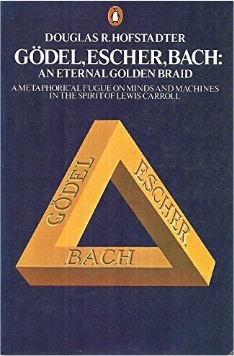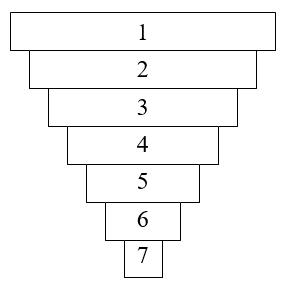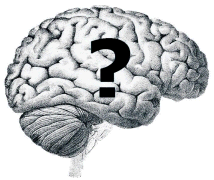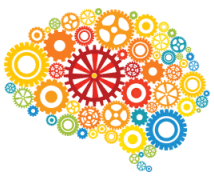Structure of this website
The structure of this website is hierarchical, consisting of a home page, a short high-level
abstract, a longer, more detailed
introduction, and a full
summary on one page, with more
levels of detail
available as you click on links and go to other pages further down the hierarchy.
Each individual page also has a hierarchical structure, with a summary at the top and bulleted points at multiple levels
that give more details at each lower level.
There is a secondary structure based on the seven
levels of description that are in the table at the top of the
summary page.
This reflects my attempt to create a hierarchical structure that is a useful model
of the workings of the human brain. The structure is very similar to the “Logical structure” table below, although this table includes a link to every lower-level page,
and a lot more detail is given on the
summary page.
| Contents of this page
|
| Logical structure - a table showing the structure of the pages that make up this website.
|
| Hierarchical structure - details on the hierarchical structure of pages on this website.
|
| Use of bulleted paragraphs - an explanation of how and why I use bulleted paragraphs.
|
| Links on these pages - details about my use of links on these pages, including references.
|
| References - references and footnotes.
|
Logical structure
The logical structure of all the pages that make up this website is shown in this table.
Scroll if necessary to see right-hand side of table →
Hierarchical structure
- A hierarchical structure for this website is appropriate
because the human brain processes data in a hierarchical
manner1,
2.
In particular, the
columns in the
layers of the neocortex
have connections within and between them that are easily able to be tuned and pruned to support hierarchical processing,
but many other areas of the brain are also able to develop a similar structure, after exposure to incoming data.
For more details on this, please see afferent processing.

- The hierarchical structure of this website evolved over several attempts
(as did the hierarchical structure of the brain, but over a rather longer period of time!).
- Initially, the structure was hierarchical in terms of level of detail
but was not based around any levels of description of the human brain.
- In March 2019, I attended a
presentation
called “The Eternal Golden Braid: Godel Escher Bach”
at the Barbican Centre in London
given by the British mathematician
Marcus du Sautoy. This presentation had been arranged primarily to coincide
with the fortieth anniversary of the publication of
Douglas Hofstadter’s book
“Godel, Escher, Bach”.
- This caused me to re-read this amazing book that I had first read in the 1990s, and I
discovered that Hofstadter discussed the subject of levels of description in the brain in some
depth3.
He does not really suggest any specific levels of description for the human brain,
but he does discuss symbols, meaning, isomorphisms and consciousness at some length.
- I then realised that the structure of this website could quite easily
be adapted to reflect levels of description that I already had in mind.
- I feel that the structure I have ended up with is ideally suited to web pages
with hypertext and hyperlinks - it could not have been implemented in a printed book.
- It seems as though evolution came up with hyperlinks in the human brain long before
the human brain invented them for the world wide web.
- However, this website uses
clickable hyperlinks
rather than synapses!

- You may consider that the table of the levels of description on the
top level summary page have what you think of
as the “lowest” level at the top, and proceed downwards going “up” levels to
the “highest” level of description at the bottom, in other words, they are upside-down.
- The “lowest” level at the top describes the smallest components of the
human brain, such as the neurons and their synapse
connections, and the “highest” level at the bottom describes brain-wide phenomena such as
consciousness that
are relatively large, certainly logically and probably physically as well.
- This is a consequence of the way we describe hierarchies using metaphors related to vertical
height and relative vertical position. It is difficult to avoid this terminology, so I do
sometimes use words such as “up”, “down”, “higher”
and “lower” when talking about hierarchies in these pages and in the brain.
- It needs to be this way up because, in order to be able to give a coherent description of the
workings of all the levels, I have to describe the “lowest” level first,
e.g. the physical structure and capabilities of neurons and
synapses, and then work “upwards”
to the “higher” levels such as consciousness.
Use of bulleted paragraphs
- As you can see, these web pages use bulleted hierarchical levels of paragraphs.
There are between one and three non-bulleted paragraphs at the top of each page that provide a summary of the page.
Further down, each top-level paragraph, like this one, gives an overview of the topic covered in that paragraph.
- The lower-level paragraphs, like this one, give more details or expand on the topic.
- If your browser does not support bulleted lists, or you are looking at a text-only translations of this page,
it may read rather strangely, so it is recommended that you view these pages in a browser that supports bulleted lists.
- I like using bulleted lists, because I find it helps me structure an argument or explanation in a logical way.
- I find a long paragraph of unstructured prose unhelpful sometimes, not because it is difficult to understand,
but because it is difficult to quickly extract the salient point(s).
- I hope that bulleted lists make the information easier to read:
- The points are separated;
- You can just read the high-level points and skip the detail if you want to.
- I do appreciate that some people may not like bulleted lists, perhaps because it feels
too much like PowerPoint slides and they have previously suffered from “Death by PowerPoint”
in a presentation or training course.
Links on these pages
- I use a lot of different categories of hypertext links on these pages.
- Links to other pages on this website are not always hierarchical.
- Although I have tried to follow my own suggestions about
useful levels of description,
there are inevitably some links between pages on this website that cross more than one level.
- For example, when describing symbol schemas, I have included
links “downwards” to afferent processing, the process
that creates symbol schemas, but also “upwards” to perception
because the existence of symbol schemas is important to the process of perception.
- This might mean that you could get “lost” between levels or even
end up in a loop.
If so, you can either press the “back” button on your browser one or more times to get back
to where you were, or refer to the very bottom of any page, where you will find links to the previous
page and also to the top level summary.
- Links to Wikipedia entries - these are automatically flagged with a pop-up when you hover over them.
For these pop-ups to work properly,
you probably need to be using a mouse and a reasonably recent version of browser.
- On any given page, or for a topic within a page, I normally only give a Wikipedia link
for a technical term once near the beginning, and do not repeat that link any more after that.
- The reason I have provided Wikipedia links is to provide supplementary information;
my aim is that they are not needed to understand my proposals, but only for background information.
- I treat Wikipedia pages as authoritative. In order to substantiate a claim I make, I generally
do not provide references to scientific papers if I have already given a Wikipedia link to a page that
explains the topic. The reason is that Wikipedia pages generally provide their own references.
- In links to other pages on this website and links to Wikipedia, I sometimes link direct to a specific
paragraph, in which case I usually use the section indicator “§” in the link text,
with the page name before it and the paragraph name after it.
For example, neurons § signals is a link to the paragraph about signals on the page about neurons.
- External links to things like magazine and newspaper articles - these are
automatically flagged with an “External link” pop-up when you hover
over them (the same assumptions about using a mouse and the browser version apply as for Wikipedia links above).
Please be aware that if you click on an external link, the destination pages are outside of my control and may
contain cookies and/or adverts.
- Superscripted footnotes that link to references at the bottom of that page.
- A superscript reference number is highlighted when you hover over it,
and a pop-up will appear saying “Click for reference”.
- When you click on such a superscripted number, you will be taken to the relevant
reference at the bottom of the page.
- There is a caret “^” (or sometimes, more than one) at the start of each reference that also is
highlighted when you hover over it, which, when clicked on, will take you back to the location of that reference.
More than one caret indicates there is more than one place on the page that cites this reference, and each will
take you back to a different place.
- In these references at the foot of a page, details of scientific papers normally include
a link from where the relevant paper can be downloaded.
- Where the source is freely available on the internet and looks reliable, I have included a link to it.
However, these sources can disappear or change quite frequently, so these links may be out of date and may not work.
- In some cases, the publisher provides a full copy of the paper free of charge, so it is
worth clicking on the first link that I provide to the publisher’s site.
- If this does not work, and I do not provide a link, or the provided link does not work, you can try the
Google Scholar link.
This will give you a list of all the sources that Google Scholar knows about for this paper, which may include
one or more links to pdf versions of the paper in the right-hand column.
- If all the above fail, you could try manual searches to find the paper.
- My first suggestion would be to put the full title of the paper into
Google Scholar,
then, if you find an exact match, click on the link below it that says “All nn versions”,
if there is such a link. You may then find a link to a pdf file in the right-hand column.
- Another possible search method is to put the full name on the paper, with a “.pdf”
suffix into the “exact word or phrase” field of
Google Advanced Search.
- These searches may not be successful; there are some scientific papers that are only available
on subscription or on payment of quite a substantial amount of money.
- I would very much like to have included online links to copies of the papers that I have obtained,
because I could have then included direct links to the relevant page and paragraph concerned,
but I decided that this was too risky because of possible copyright issues.
- In my references, I have tried to include exact quotations and page numbers
wherever possible. (I have sometimes been frustrated when a specific claim is made in a
scientific paper or book which gives a reference to a paper that you assume
backs up or justifies the claim being made, but the reference only gives the
title of the paper and no further help on why, where or how that paper is related
to what is being claimed. On some occasions I have read through the whole paper and have not
been able to find the justification of the referenced claims.)
- The subjects of some of the articles, books and scientific papers that are referenced
are inevitably not solely about the topic I am describing, which is another reason why I have always
tried to provide exact quotes and page numbers.
- Within a quotation from a paper or book, anything within square brackets [like this] is my addition,
most often as an explanation of a technical term or abbreviation, but sometimes to give the context of the quotation,
or to allow it to make sense.
- A reference that says Ibid. (which is short for “Ibidem”, meaning “in the same place.”)
followed by the title of the paper, means that the full details of the paper including its location can be found in a previous reference,
often the one immediately preceding, but otherwise the last preceding one that is not an Ibid.. An exception to this is for
references to online resources, where I have normally repeated the online links on each Ibid., because in some cases they are different.
- In references to scientific papers, I have included a link to a “DOI”
where this is available. These links are automatically flagged with
“Digital Object Identifier” (as for this text) when you hover over the link
(the same assumptions apply as to Wikipedia and external links above). A
Digital Object Identifier is a link used for many scientific papers that
ensures that you can find the original publisher even if it moves between sites.
-
^
Circular inference: mistaken belief, misplaced trust - Deneve and Jardri 2016
doi: 10.1016/j.cobeha.2016.04.001
(download not available, although see
GoogleScholar).
Page 41, under the heading “In search of a neural mechanism”: “The brain is inherently hierarchical and progressively constructs increasingly more abstract interpretations of its environment.”
-
^
A Theory of How Columns in the Neocortex Enable Learning the Structure of the World - Hawkins, Ahmad and Cui 2017
doi: 10.3389/fncir.2017.00081
downloadable here or see
GoogleScholar.
Page 12, under the heading “Hierarchy”: “The neocortex processes sensory input in a series of hierarchically arranged regions... A common assumption is that complete objects can only be recognized at a level in the hierarchy where cells respond to input over the entire sensory array.... the cortex learns multiple models of objects, both within a region and across hierarchical levels.”
-
^
Godel, Escher, Bach - Douglas Hofstadter Penguin Books UK 1979
This fascinating book, despite its title, is mostly about the functioning of the brain, although it covers many other subjects as well.
See chapter 10, page 285 onwards, under the subheading “Levels of Description”,
for a general discussion on levels of description.
Chapter 17, under the heading “Formal and Informal Systems” on Page 559: “The only way to understand such a complex system as a brain is by chunking it on higher and higher levels, and thereby losing some precision at each step.”
Chapter 17, under the heading “Irrational and Rational Can Coexist on Different Levels”, bottom of page 575:
“meaning can exist on two or more different levels of a symbol-handling system”, hence Hofstadter also refers to “levels of meaning”.
Page last uploaded
Thu Feb 22 14:20:41 2024 MST



